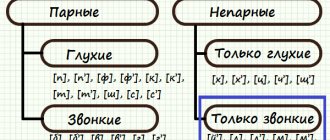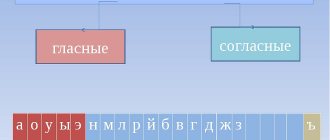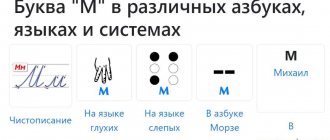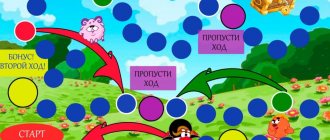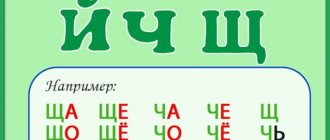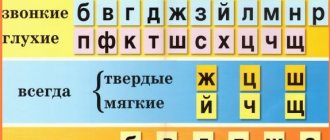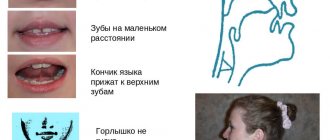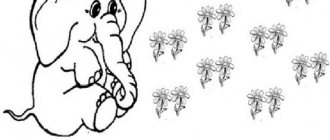- home
- Directories
- Handbook of Russian for elementary school
- Sounds and letters
- Consonant sounds and letters representing them
- Voiceless and voiced consonants
Consonant sounds can be pronounced with a greater or lesser degree of sonority. In accordance with this, voiced and voiceless consonants are distinguished.
Voiceless consonant sounds are made up of noise, while voiced consonant sounds are made up of noise and voice.
Some consonant sounds are paired in terms of voicedness and voicelessness , i.e. can be voiced or devoiced depending on their position in the word. And some are unpaired , i.e. their sound does not depend on position.
Table of consonant sounds paired and unpaired by voicedness/voicelessness:
| Groups consonants | Doubles | Unpaired |
| Voiced | [b], [b'], [c], [c'], [d], [g'], [d], [d'], [g], [h], [z'] | [th'], [p], [p'], [l], [l'], [m], [m'], [n], [n'] |
| Deaf | [p], [p'], [f], [f'], [k], [k'], [t], [t'], [w], [s], [s'] | [ts], [x], [x'], [h'], [w'] |
Consonant paired voiced sounds are deafened:
- at the end of the word - tooth b [zu p ], hundred g [hundred k ], plo v [plo f ]
- before voiceless consonant sounds - lips ki [gu p ki], spoon [ loshka ] , low [n'is ka ]
Consonant paired unvoiced sounds are voiced:
- before voiced consonant sounds - with delka [ z' d'elka], grind ba [small d' ba]
The correct spelling of paired consonants based on voicedness/voicelessness is an orthogram that requires a test word.
unpaired in terms of voicedness/voicelessness are not deafened or voiced, regardless of where in the word or before what sounds (voiced or voiceless) they are located.
For example: rubbish [litter], house [house], crust [crust], Dimka [dimka]
Share with friends on social networks:
Russian language with tutors online
Now you can learn the Russian language on your own, using the free resources of our educational website, as well as choose a suitable tutor from our partner and study at the TutorOnline school:
- Individual sessions
- Affordable prices
- Convenient payment methods
- Free introductory lesson
- Money Back Guaranteed
How to choose a Russian language tutor
Free trial lesson with a tutor
Consonants and letters
What sounds are called consonants? What does a consonant sound consist of? What are the different consonant sounds? How many consonant letters and consonant sounds are there in the Russian alphabet? Which consonants are always hard and which are always soft? What letters indicate the softness of a consonant?
Sounds in the pronunciation of which the air encounters an obstacle in the mouth are called consonant sounds . A consonant sound consists of noise and voice or only noise.
Consonant sounds are divided into voiced and voiceless . Voiced ones consist of noise and voice, while deaf ones consist only of noise.
The following sounds are made up of noise and voice: [b], [v], [d], [d], [z], [z], [y], [l], [m], [n], [r] . These consonant sounds are called voiced.
The sounds only consist of noise: [k], [p], [s], [t], [f], [x], [ts], [ch], [sh], [sch]. These are voiceless consonants.
Many consonant sounds form pairs based on voicedness and deafness : [b]—[p], [v]—[f], [g]—[k], [d]—[t], [z]—[s], [g]—[w].
To memorize voiced consonants, you can learn the phrase: “ The Lion and the Toad HAVE MANY FRIENDS .” See all phrases for memorizing voiced and voiceless consonants.
Voiceless consonants are easy to remember from the phrase: “ Styopka, Do you want ShcheTs?” - Ugh! "
Consonant sounds are indicated by letters:
B , V , G , D , F , Z , J , K , L , M , N , P , R , S , T , F , X , C , H , W , SCH .
21 consonants in the Russian language .
Consonant sounds are also hard and soft.
Hard and soft sounds differ in the position of the tongue when pronounced. When pronouncing soft consonants, the middle back of the tongue is raised towards the hard palate.
Most consonant sounds form pairs based on hardness and softness:
| Solid | [b] | [V] | [G] | [d] | [h] | [To] | [l] | [m] | [n] | [P] | [R] | [With] | [T] | [f] | [X] |
| Soft | [b'] | [V'] | [G'] | [d'] | [z'] | [To'] | [l'] | [m'] | [n'] | [P'] | [R'] | [With'] | [T'] | [f'] | [X'] |
The following hard and soft consonant sounds do not form hard-softness pairs:
| Solid | [and] | [w] | [ts] |
| Soft | [h❜] | [sch❜] | [th❜] |
Table “Consonant sounds: paired and unpaired, voiced and voiceless, hard and soft” (grades 1-4)
Note: in elementary school, hard consonant sounds are indicated in blue, soft consonant sounds in green, and vowel sounds in red.
The hardness of consonant sounds is indicated in writing by the vowels A , O , U , Y , E.
The softness of a consonant sound is indicated in writing by the vowels E, E, I, Yu, I , as well as the letter b (soft sign).
Compare: nose [nose] - carried [n❜os], corner [angle] - coal [ugal❜].
Unpaired voiced sounds [й❜], [l], [l❜], [m], [m❜] [n], [n❜] [р], [р❜] are called sonorant , which translated from Latin means "resonant".
The sounds [zh], [sh], [ch❜], [sch❜] are called hissing . They got this name because their pronunciation is similar to hissing.
The sounds [zh], [sh] are unpaired hard hissing sounds. The sounds [ch❜] and [ш❜] are unpaired soft hissing sounds.
The sounds [c], [s❜], [z], [z❜], [ts] are called whistling .
A consonant sound is neither stressed nor unstressed.
In the Russian language, there are more consonant sounds (36) than consonant letters (21), since one letter can denote paired hard and soft sounds: for example, the letter L (el) denotes the sounds [l] and [l❜].
Attention! A consonant sound can form a syllable only with a vowel sound .
►
Techniques for producing sounds T D
The classic techniques of speech therapy work are the preparatory stage and sound production, which can also be actively used in home exercises. If you choose the right exercises, it will not be difficult for parents to cope with their child’s speech disorders.
Important: before teaching a child the correct articulation of the sound T ( D ), the adult must himself practice the position of the lips and tongue in front of the mirror: the lips take the position of the vowel that follows T (ta - ta - ta); the tongue is fixed in the upper teeth; the palate is raised. In addition, articulatory gymnastics must also be previously rehearsed by an adult.
Preparatory stage
Speech therapists insist that if the baby’s tongue is not strong enough to make sounds, it is necessary to first strengthen the muscles of the tongue and lips. Therefore, the preparatory stage necessarily includes articulation gymnastics. Speech therapy massage exercises will help prepare the speech apparatus for it::
- An adult, using a mirror, teaches the preschooler to take the correct position of the lips and tongue, showing the differences in pronunciation, for example, T (tip of the tongue) and K (tail of the tongue): “The cake is being eaten,” “Drops are dripping.”
- Making the T requires a sharp and strong exhalation. Therefore, it is necessary to develop the ability to exhale correctly. You can use the following exercises: “Soap bubbles”, “Balloon”, “Flying snowflakes (from a napkin or cotton balls)”.
- Then follows articulation gymnastics:
- “Wide smile” – connect your teeth, stretch your lips wide and hold this position for up to 7 seconds.
- “Tick-tock clock” - the tongue quickly moves left and right along the upper lip.
- “The tongue does not obey” - say five-five-five, tapping your upper lip on your tongue, gradually differentiating (distinguishing) the sounds P T.
- “Tongue - spatula” - relax the tongue, making it wide, place it on the relaxed lower lip.
Important: we must try to make it interesting for the child to complete rather monotonous preparatory tasks. To do this, it is necessary to introduce new articulatory gymnastics exercises, which can be borrowed from speech therapy practice, at each home lesson.
Staging sounds
How to install sound at home? Experts offer several ways to set sound; a parent can try all of them and choose the one that is more accessible and understandable to the baby.
- Setting T by imitation: an adult invites a preschool child to repeat first the syllables, and then the words; it is advisable to start with the syllable “ta”. For example: ta-ta-ta, ta-you-to-tu, you-you-you, you-ta-to-tu, to-to-to, to-tu-ta-you. Then the transition to words - pure words: ta-ta-ta, ta-ta-ta, such beauty; you-you-you, you-you-you, gave us flowers; tu-tu-tu, tu-tu-tu, we clean up; so-and-so, so-and-so, I put on my coat. A creative approach to speech activities will allow parents to independently compose similar phrases in sound, involving children in creativity.
- Interdental method: an adult shows the child the position of the tongue (the tongue is pressed between the lips, in this position you need to exhale strongly until you hear a sound, then place the tongue behind the teeth). You can teach how to control your exhalation by playing a “fence” for air by placing your palm in front of your mouth. Or arrange a game of “ball” (a cotton ball is driven into an improvised goal with a stream of air).
- Speech therapists use the method of setting T from the sound P. The child repeats pa-pa-pa, placing the wide tip of the tongue on the lower lip, then, smiling broadly, pronounces P , resulting in T.
- When setting D , the work is identical, only when exhaling the voice is added.
Automation of sounds T D
When the sounds T D are delivered (correct articulation has appeared) and the child learns to pronounce them, the next stage begins - automation (practice of the skill). It is important to achieve fluent pronunciation here. Since this is new for a preschooler, it means a lot of training is required. Speech therapists recommend introducing the practiced skill gradually: first through syllables, then words, then sentences. Articulation exercises, games based on poetry, stories, riddles will help well in this work, which will also maintain interest in the classes. At the same time, do not forget that every home lesson must begin with articulatory gymnastics.
Important: parents need to make every effort to ensure that the incorrect pronunciation of T D disappears from the child’s speech as quickly as possible. It should be taken into account that new material is introduced only after the previous one has been mastered.
What can an adult do to keep the child interested in activities and at the same time repeat monotonous actions over and over again? Gaming techniques will help, with the help of which syllables are practiced, for example: ta-ta-ta, yes-da-da, to-to, do-do-do, ta-you-to-tu, at-at-at, yes-dy-du, yt-yt-yt, ud-ud-ud. Plots can be very diverse:
- Let's teach the doll to brush its teeth, show it what articulation gymnastics is: “let's brush the teeth” (various movements of the tongue on the teeth from the outside and inside, up and down, left and right).
- Let's sing a song to the toys: “tra-ta-ta, tra-ta-ta, we are taking a cat with us”;
- Play the drum for the bear: tram-ta-ta-tam; on a dog pipe: doo-doo-doo.
- I start speaking, and you finish (the adult pronounces part of the word, which must end in a syllable with the sounds T D ): flowers, beauty, candy, mast, coat, bouquet; bicycles, sneakers, beards.
- Hello, little finger! (the thumb is put forward, and each finger in turn “greets it” with the syllables: ta, to, tu, you; yes, do, du, dy).
After the preschooler has automated sounds, the work becomes more complicated, the pronunciation of sounds is fixed in words.
Exercise “Collecting beads”
An effective exercise on automating the sound T with older preschoolers. An adult invites the preschooler to collect unusual beads, having previously agreed which syllable should follow which. For example, there may be such a sequence: that - that - you - that - that - that. Work with the sound d is carried out in a similar way. At first, you can rely on visual aids (colored beads, circles of colored paper, pencils). Subsequently, the visualization is removed, and the child acts from memory.
Exercise “Come up with words with the sounds T D”
Invite the child to repeat after the adult words with the sounds T D at the beginning, middle, and end of the word. For example, an adult starts with a more understandable syllable ta : ta kidneys, ta chka, ta reel; The baby continues: ta NK, ta Buret, ta Nets, ta Xi. Then he moves to another position T D : cat , cock , roll , leaf ; sala t , play t , collect t , bark t , help t . Or daughter , yes , day , gifts , soldier ( voice emphasis on the highlighted one). If at first it is difficult for a preschooler to continue his vocabulary, you can work with pictures. The work with the syllables you dy : you qua, hole , you , dy m; then to : then por, then mouth, then thick, kind , then chka, dochka ; tu du : tu chka, tu loop, ra du ga, du ga. It is better to prepare the vocabulary in advance. An even more interesting automation exercise will take place with a ball. The adult throws the ball to the child with his word, the child responds with his own.
Exercise “Sound t and sound d in a sentence”
Similar work is done with sentences; the preschooler repeats after the adult, emphasizing T D :
- Tanya and Tom are traveling on a tram.
- Trofim is riding in a taxi.
- The plane is flying.
- Aunt Tonya is planting flowers.
- Dima and Tolya are skating on the skating rink.
- Dasha and Denis shared the melon.
- Children go to kindergarten.
In order for a preschooler to be able to independently compose a sentence, plot pictures are used. It is necessary to ensure that all words of the sentence have a sound that is automated ( T D ).
Nursery rhymes, pure sayings for automating sounds etc.
To make it easy for parents to choose an artistic series for practicing the sounds of T D, you can use speech therapy selections or come up with pure sounding phrases together with your children. For example, the parent starts with syllables, and the child then rhymes the sentence:
- Ta-ta-ta, ta-ta-ta, (they saw a whale in the sea ) .
- Tu - tu - tu, tu - tu - tu, (let's pour some milk into it ).
- Yes - yes - yes, yes - yes - yes, (splashed all over with water ) .
- water in the glass ).
- Yes - yes - yes, yes - yes - yes, (don't go there ) .
- doo , (go there anyway ).
A lot of nursery rhymes can be found on children's websites or in children's books. Their main task is to automate the sound T ( D ), its correct pronunciation, for example:
Shadow, Shadow, Shadow, above the city there is a fence. The animals sat on the fence and boasted all day long. The fox boasted: I am beautiful to the whole world! The bunny boasted: Go, catch up!
Pull the canvases, the canvases are simple. Pull, Pull, Pull, Across, across.
We know, we know: Yes-Yes-Yes! Water is hiding in the tap! Come out, water! We came to wash up!
LaDushki, LaDushki, Let's bake pancakes. We'll put it on the window. Let's leave it to cool. Let's wait a little, Let's give pancakes to everyone.
Differentiation of sounds D T
An important stage in speech therapy work is the differentiation of sounds (distinguishing similar sounds, T D, D D, T T). This stage is carried out in parallel with automation and is necessary in order to compare sounds (soft and hard) and practice pronunciation. You can teach a preschooler new special techniques for distinguishing sounds: a hand is applied to the throat while sounding, the sound is determined ( D - voiced, voiced; T - deaf, without a voice). For differentiation, you can use already known techniques: syllables, words, sentences in exercises, games, sayings, nursery rhymes.
Differentiation of sounds T ТТ in the exercise “Compare sounds in guesses”
An adult asks the child to guess riddles, and then asks if the sound of T in all the riddles? The main thing is to make it possible to understand the difference in the pronunciation of the sounds T (hard) T (soft).
Round, not a month, yellow, not butter, Sweet, not sugar, with a tail, not a mouse ( you kwa).
He bows, bows, when he comes home he will stretch out ( then ).
A block froze over the water, and she dreams of fish for lunch. There are fins and too lazy to swim, the fish will be eaten by another ( seal laziness).
Exercise “Correct phrasing”
The goal is to teach how to pronounce and distinguish DY .
Grandfather Dodon played the pipe, Grandfather hit Danka with the pipe.
A woodpecker is chiseling a tree, Day after day crushes the bark.
Game "Come up with a proposal"
To establish and consolidate the pronunciation of T D , adults can teach children to come up with beautiful sentences while relying on verbal helpers. Then determine which words have hard T D and which have soft Т Дь:
Denis - telephone (Denis was given a telephone); Home is a cat (Our cat doesn’t walk, he’s at home); Tanya - melon (Tanya loves melon); Tyoma is a pipe (Tyoma learns to play the pipe); Dusya - pictures (Dusya loves to look at pictures);
Important: parents should understand that home exercises for correct pronunciation consist of developing the skill of pronouncing the sounds of their native language. This process is long, systematic, and requires patience and persistent training in automation and sound differentiation. A thoughtful selection of articulatory gymnastics, exercises, games, and verbal material will help to achieve good results in the development of competent, beautiful speech in preschool children.
Consolidating knowledge
You can consolidate the material covered by asking your child to compile and fill out such a table. This will also connect motor memory.
A good way to learn to distinguish consonants is to play “dispersing” sounds into “apartments” in a drawn “house”. For example, voiced unpaired ones - in apartments with blue windows, paired ones - with yellow and orange ones, unpaired unpaired ones - with green ones.
It is useful to look for different letters in words. You can give your child examples of words with voiceless consonants, then with voiced consonants, and show that both words can end at the end. You can show how the sorceress Phonetics turns deaf into voiced and vice versa.
Let the sign drawn by the child always hang before his eyes, so that he can periodically return to it and repeat the material. For a child, first of all, it will be a game, but with its help he will study an important topic that will be very useful for him in his studies.
Stunning of voiced consonants
Voiced consonants, if they are at the end of a word, are in a weak phonetic position and are subject to deafening. When pronounced, they are replaced by their paired voiceless consonants:
- box [box]
- norov [noraf]
- threshold [steam]
- parade [parad]
- watchman [stohrash]
- frost [frost].
If a voiced consonant is located before a voiceless one, then similarly this is a weak phonetic position for it. The voiced consonant is affected by the voiceless consonant and becomes similar to it, that is, it changes its quality and sounds muffled. Assimilation of a voiced consonant occurs (Latin assimilatio - “likening”, “comparison”) on the basis of deafness/voice.
Let's observe:
- shelling [a p s t r' e l]
- pampering [bal a f s t v o]
- factory [za v a t s k o y']
- pointer
- tramp [b r a d ' a sh k a].
Consonant sounds do not form a phonetic syllable on their own, but only when paired with vowel sounds.
When to start training?
In fact, the initial stage of learning occurs at an even earlier age, when we teach the baby to distinguish between different sounds. Then we study all the letters of the alphabet, give the concept of vowels and consonants, and teach the child to determine the presence of each of them by ear. Only after this will the baby be able to understand the difference between voiced and deaf and learn to hear them in words.
That is, first you need to develop phonemic hearing in a preschooler - that same ability to isolate individual sounds from speech. How to do it?
- Teach to respond to the sound of rattles by turning your head in their direction.
- We teach a grown-up toddler to listen to nature outside the window: let him close his eyes and describe what he hears (the hum of the wind, the rustling of leaves, the chirping of birds, the noise of cars, barking dogs, etc.).
- We do the same with household appliances at home: let them distinguish the sound of a hairdryer, vacuum cleaner, kettle, refrigerator.
- We play at the zoo: the mother imitates the voices of different animals and birds, and the child guesses them, and then vice versa.
- Let the blindfolded child determine what sounds: a bell, a tambourine, a whistle, etc.
- After he has learned all the letters, you can teach him to identify their presence in words (for example, have him clap or stand up if he hears a given sound).
That is, before studying the voicedness - deafness of consonants, a preschooler must:
- know all the letters of the alphabet, their order, quantity;
- distinguish vowels from consonants;
- have developed phonemic awareness.
All these skills can be developed in a preschooler by the age of 5–6 years.
In order for your baby’s phonemic hearing to develop correctly, try to communicate with him as much as possible, and also make sure that there is no constant background noise around him (a TV that doesn’t turn off, a music player).
Pairs of voiced and voiceless consonants
Voiced and unvoiced sounds and the letters denoting them are contrasted in Russian and form pairs:
- b-p,
- w-f,
- g-k,
- d-t,
- ss,
- w-sh.
If we take into account that the consonants in these pairs can also be soft (except zh-sh), then there are a total of 11 contrasting pairs of deafness and voicedness. The listed sounds are called paired. The remaining voiced and unvoiced sounds do not have pairs. The voiced unpaired ones include the above sonorants, and the voiceless ones include x, c, ch, shch. The table of consonants presented on our website will help you study these sounds in more detail.
Click on the picture to print a table with voiced and voiceless consonants
How is it that letters in the Russian alphabet can represent several sounds?
Features of the pronunciation of a sound are often predetermined by its position in the word. Thus, a voiced sound at the end of a word is deafened, and this position of the sound is called “weak”. Stunning can also occur before the next voiceless consonant, for example: pond, booth. We write voiced consonants and pronounce: twig, butka.
Conversely, a voiceless consonant can become voiced if it is followed by a voiced sound: threshing, but we pronounce maladba. Knowing this feature of Russian phonetics, we check the spelling of consonants at the end and middle of a word using test words: molotba - thresh, pond-ponds, booth - booth. We select the test word so that after the dubious consonant there is a vowel.
To remember what a sound is according to its characteristics, it is necessary to make mental associations of the sound with some object, event or natural sound. For example, the sound sh is similar to the rustling of leaves, and the sound z is similar to the hum of bees. The association will help you find your way in time. Another way is to create a phrase with a specific set of sounds.
Thus, knowing the letter-sound relationship is extremely important for spelling and correct pronunciation. Without studying phonetics, it is impossible to study and correctly perceive the melody of a language.
Video lesson about voiced and voiceless consonants:
Tralik and Valik about voiced and voiceless consonants
Another video lesson for children with riddles about voiced and voiceless consonants

